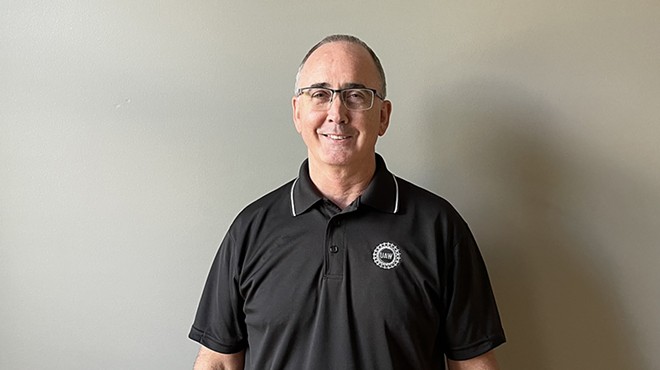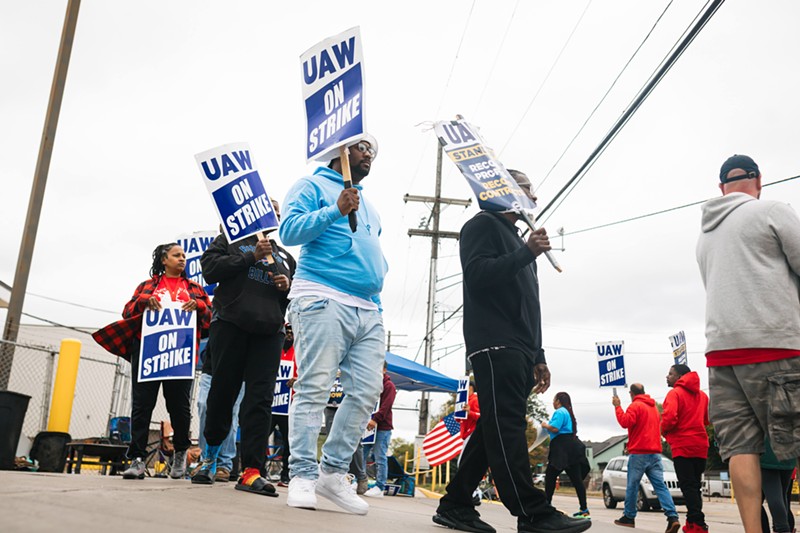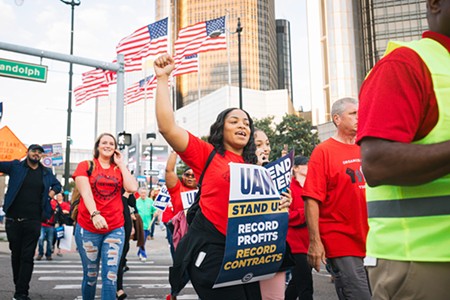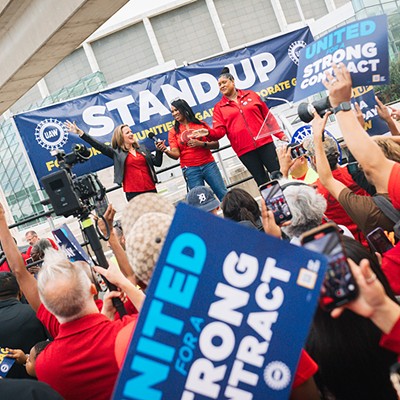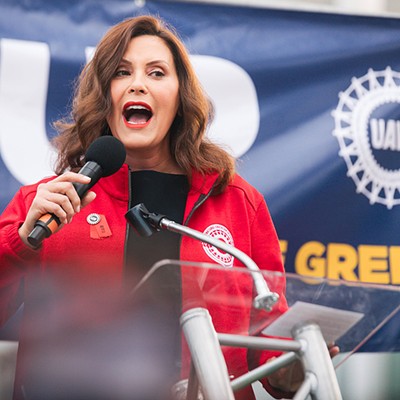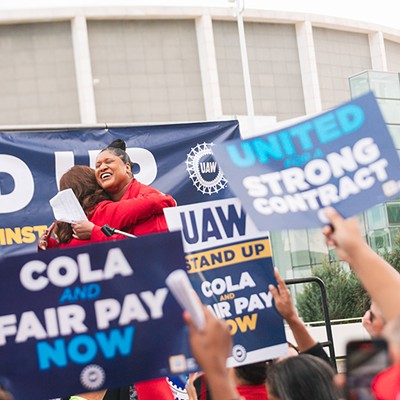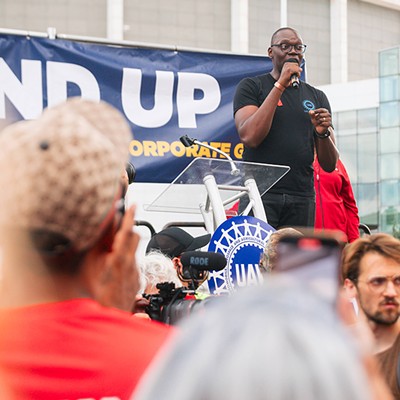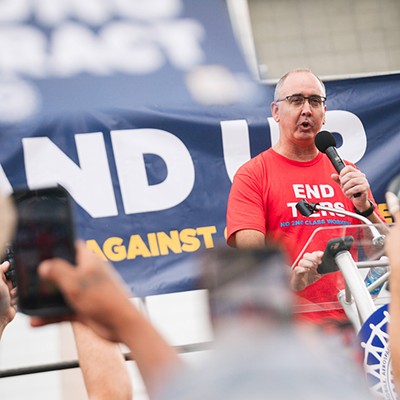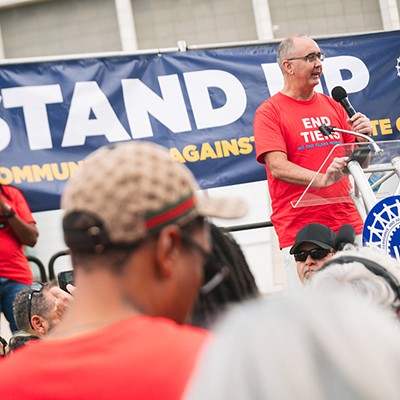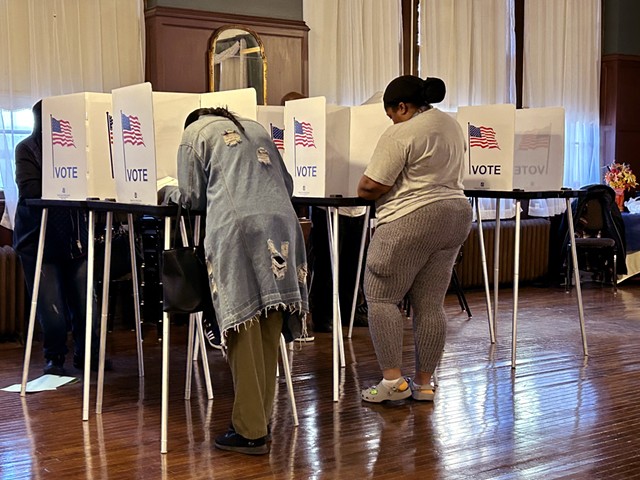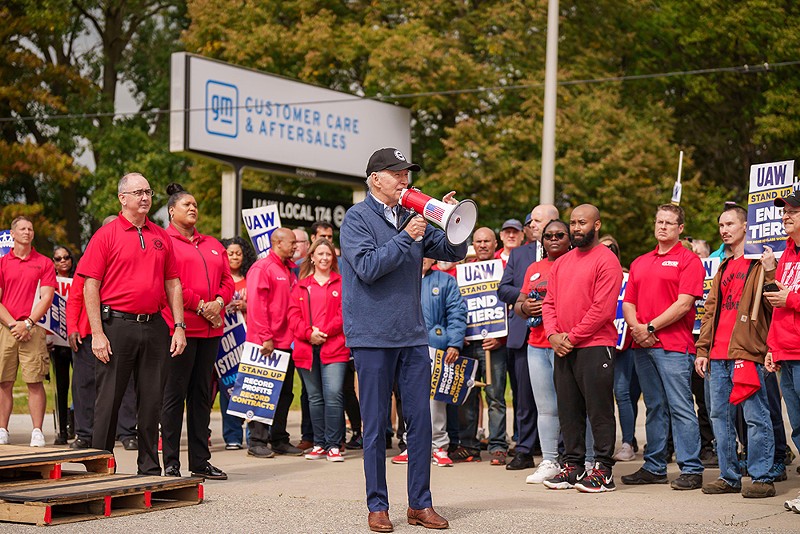
President Joe Biden has claimed he is “the most pro-union president leading the most pro-union administration in American history.” In at least one symbolic way last week, he delivered, doing something no other sitting U.S. president had ever done before: join a picket line.
Under their new leader Shawn Fain, some 25,000 of the United Auto Workers’ 150,000 members who work for the Detroit Big Three carmakers are on strike, demanding higher wages and better working conditions. Launched at midnight on Sept. 15, it’s the first time the union has ever been on strike against all three companies simultaneously. But U.S. presidents typically don’t meddle in such labor disputes, seeing themselves more as mediators between workers and their bosses.
Biden apparently considered that to be a bunch of malarkey. During his 15-minute stop at the picket line last Tuesday, Biden, wearing a UAW baseball hat, grabbed a bullhorn emblazoned with American flag decals and spoke to workers at the General Motors Willow Run Redistribution Center in Belleville.
It may seem like a small, bare-minimum gesture — or, at worst, a cynical ploy for votes in a battleground election state. (Last year, Biden signed legislation to block a national U.S. railroad strike that could have devastated the American economy, in a dispute over paid sick days for railroad workers.) Steven Rattner, former President Barack Obama’s “car czar,” said he was shocked by Biden’s decision. “For him to be going on a picket line is outrageous,” Rattner said in an interview with NBC News. “There’s no precedent for it. The tradition of the president is to stay neutral in these things.”
And yet, the substance of President Biden’s brief message to the workers is unimpeachable, and hardly controversial.
“The fact of the matter is that you guys, the UAW — you saved the automobile industry back in 2008 and before,” Biden said, referring to the concessions the autoworkers made when the U.S. government bailed out the Big Three more than a decade ago. “You made a lot of sacrifices. You gave up a lot. And the companies were in trouble. But now they’re doing incredibly well. And guess what? You should be doing incredibly well too. It’s a simple proposition.”
He added, “Folks, stick with it, because you deserve the significant raise you need and other benefits. Let’s get back what we lost, OK? We saved them; it’s about time for them to step up for us.”
Fain took the bullhorn next, noting the historical significance of the site — Willow Run was part of the “Arsenal of Democracy” that helped win World War II, at its peak churning out one B-24 Liberator bomber plane per hour.
“So, today, 80 years later, we find ourselves here again, with the arsenal of democracy. It’s a different kind of arsenal of democracy, and it’s a different kind of war we’re fighting,” Fain said. “Today, the enemy isn’t some foreign country miles away. It’s right here … it’s corporate greed.”
He added, “And the weapon we produce to fight that enemy is the liberators — the true liberators — it’s the working-class people. All of you working — working your butts off on those lines to deliver a great product for our companies.”
He concluded, “That’s how we’re going to defeat these people. That’s how we’re going to defeat corporate greed, is by standing together.”
Biden chimed in. “You’ve heard me say it many times. Wall Street didn’t build the country,” he said. “The middle class built the country, and unions built the middle class. And that’s a fact. So, let’s keep going.”
He added, “You deserve what you’ve earned, and you’ve earned a hell of a lot more than you’re getting paid now.”
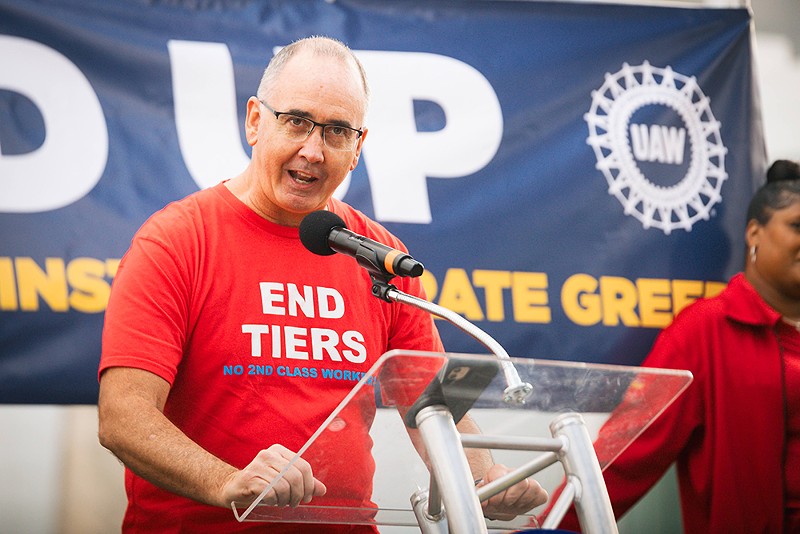
‘There is a new sheriff in town’
Fain has hit the ground running, calling the historic strike just months after winning the UAW presidency in a hotly contested upset in which hundreds of ballots were challenged. In the end, Fain won by less than 500 votes.
A 54-year-old electrician from Kokomo, Indiana, Fain has been a UAW member for more than 20 years, first joining at a Chrysler plant. Fain has said his family’s union ties run deep, with three of his four grandparents being early UAW members; he keeps a pay stub from one of his union grandfathers in his wallet as a memento.
As president, Fain had promised to clear house at the UAW, which had become mired in corruption scandals that resulted in more than a dozen union officials including two former presidents charged with crimes including embezzlement, kickbacks, and collusion. In response, the U.S. Department of Justice brokered a consent decree with the union that gave UAW members the ability to choose leadership by direct vote, as opposed to a system of delegates, which critics said encouraged cronyism.
“For too long, this union has been divided,” Fain said in his video victory speech. “We’ve been divided by corruption and self-serving leadership at the top. The UAW once set the standard for what a clean, progressive, member-led union looks like. But the last few decades have seen us veer far off course. UAW officers, the people elected to lead and serve this great union, have taken bribes, stolen dues, and betrayed the trust of the membership. That ends here.”
In a draft transition document obtained by the Detroit Free Press, Fain detailed his plans to dramatically “shake up” the union. “There is a new sheriff in town, something different is happening,” Fain wrote, adding, “If we do this well, then heads are going to be spinning with how fast things are going to change.”
Fain’s brash style and social justice bent has drawn comparisons to previous UAW president Walter Ruether, who similarly came to power in a close election. In his speeches and livestreams on social media, Fain has a tendency to quote the Bible and figures like Malcolm X. Fain is also fond of publicity stunts, theatrically throwing a UAW contract offer from Stellantis into a waste basket during one livestream, saying, “That’s where it belongs — in the trash — because that’s what it is.”
In announcing the strike, Fain revealed an innovative new strategy that he has dubbed a “stand up strike.” Instead of calling on all workers to stop work at once, Fain is staggering the strike, targeting specific plants at a time. The tactic is something of a callback to the UAW’s famous “Flint sit-down strike” of 1936 and ’37, in which workers took over a General Motors plant and refused to work — a daring move that helped transform the then-nascent union into a major powerhouse for organized labor.
One of Fain’s more seemingly audacious demands includes a call for a four-day workweek for five days’ of pay (though we’ll get to that later), and the UAW could be gearing up for a long fight. The “stand up strike” strategy allows Fain to conserve the UAW’s strike fund and also allows gives the union added power in its negotiations with the Big Three; Fain can target the separate companies depending on how negotiations are going, while at the same time preventing the auto industry from grinding to a complete halt, which would have ramifications in the wider economy — especially in a place like the Motor City. Last Friday, Fain said his planned livestream announcing additional strike targets was delayed by about a half hour due to last-minute negotiations with Stellantis; that automaker’s plants were spared in the new round of strikes because negotiations were going favorably, he said.
In recent years, European countries have experimented with testing four-day workweeks, and the results have reportedly been overwhelmingly positive, with improvements in productivity and worker morale.
tweet this
The metro Detroit-based World Socialist Web Site has been critical of Fain’s stand-up strike approach, however, pointing out that if he was serious about causing pain, he would call strikes at the companies’ main profit-making centers, which produce pick-up trucks. It also noted that Fain has largely declined to target Detroit-area plants, alleging that such a move in the U.S. automotive capitol “could quickly trigger uncontrollable demands by workers throughout the region to join industrial action.”
The union “is seeking to placate workers with false promises of ‘expanding’ the strike,” the WSWS claims. “This is intended to wear workers down and prepare the ground to announce contracts that will be completely in line with the company’s demands for massive attacks on jobs and workers’ living standards.” The WSWS has called for UAW workers to demand an all-out strike.
If Fain is in cahoots with the Big Three, it seems that the companies’ own CEOs must not have gotten the memo. Ford Motor Co.’s Jim Farley accused Fain of “holding the deal hostage” over the company’s planned electric vehicle battery plants, claiming the UAW’s demands would hinder the company’s progress. (Fain has also called on the Big Three to make sure there is a “just transition” to E.V. production that maintains jobs for UAW members.) Meanwhile, GM’s Mary Barra claimed the UAW has “no real intent to get to an agreement.”
“It is clear Shawn Fain wants to make history for himself, but it can’t be to the detriment of our represented team members and the industry,” Barra said. “Serious bargaining happens at the table, not in public, with two parties who are willing to roll up their sleeves to get a deal done.”
In response, the UAW said on social media that neither Farley nor Barra attended bargaining discussions that week — and added that both executives made a combined $50 million in compensation last year.
Metro Times reached out to the UAW to interview Fain, but we did not get a response.
Been down so long, it looks like up
Like many union workers across industries, Fain has called for an end to the practice of multi-tier workers, in which newer hires are paid less than legacy hires and receive fewer benefits; while this process may be good for companies’ bottoms lines, it absolutely saps worker morale.
Speaking from a picket line in Warren, Trina Johnson, vice president of the UAW Local 1248, tells Metro Times that she has worked for what is now Stellantis for 28 years, but has gone 12 years without a raise. “We’ve lost [cost-of-living adjustment], we’ve lost some holidays, and now it’s time to gain all of that back,” she says. “We want record contracts, because they have record profits. And that’s what we’re out here for, fighting for our pay and our livelihood.”
For the past few decades, it’s been an absolutely fabulous time to be the richest 1% in the U.S.; for the rest of us, not so much. Some 720 or so billionaires now own nearly twice the wealth as the entire bottom half of Americans combined, or about 165 million people — $4.56 trillion versus $2.62 trillion. It’s a mind-boggling level of inequality that has only been exacerbated in recent years, as millions of Americans struggle to pay for rent and groceries and CEOs amass more wealth than they will ever be able to spend. There is no scarcity problem in the U.S., only a gross misallocation of resources. Worker anger at the Big Three is a symptom of a wider, systemic problem.
This decline in fortunes for the working class has coincided with a decline in union power. In fact, union membership in this country is at an all-time low, according to data released by the U.S. Bureau of Labor Statistics earlier this year, which found that the rate of union representation fell from 10.3% in 2021 to 10.1% in 2022. (That’s despite an increase in union representation; according to the Economic Policy Institute, in 2022, more than 16 million workers in the U.S. were represented by a union, an increase of 200,000 from 2021. While more jobs were unionized, nonunion jobs have been added to the economy at a faster rate.)
That doesn’t mean that more workers don’t want to be in unions. Between October 2021 and September 2022, the National Labor Relations Board saw a 53% increase in union election petitions, the highest single-year increase since fiscal year 2016. The study also found that more than 60 million workers wanted to join a union in 2022, but couldn’t, due to strong corporate power and union-busting tactics.
There have been signs that a new era for organized labor could be upon us. Earlier this year in Michigan, Gov. Gretchen Whitmer repealed the state’s so-called “right-to-work” laws, which had weakened unions by not requiring union members to pay dues.
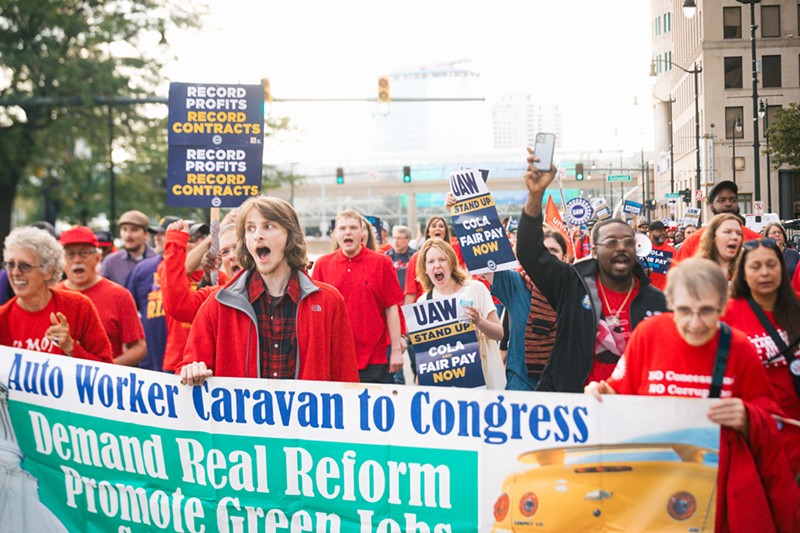
That followed a series of high-profile union efforts in recent years at some of the biggest corporations across the country. Workers at a Starbucks store in Buffalo, New York formed a union in December 2021 — the same year residents there nearly elected a democratic socialist mayor — kickstarting a new era in labor organizing at the coffee chain that has seen more than 8,000 workers at more than 330 stores move to unionize, though none have yet enacted a collective bargaining agreement. Last year, workers at an Amazon warehouse in Staten Island formed the first union at the online retail titan, though the company also has yet to reach a bargain agreement.
In Hollywood, a double strike by the Writers Guild of America (WGA) and the Screen Actors Guild – American Federation of Television and Radio Artists (SAG-AFTRA) shut the film and television industries down for nearly five months in a dispute over compensation for digital streaming services and better working conditions. While the WGA reached a deal last week, ending its half of the strike, negotiations with SAG-AFTRA remain ongoing.
The Hollywood double strike was another historic moment, as it was only the second time in history that both unions went on strike simultaneously. Ironically, the first time this happened, in 1960, the president of the Screen Actors Guild was Ronald Reagan.
Once a registered FDR-loving Democrat, Reagan drifted rightward after the strike. A group of businessmen convinced him to run as the Republican candidate for Governor of California, launching a political career that would eventually take Reagan to the White House. Just months after he was elected U.S. President in 1980, Regan fired 11,500 striking air traffic controllers, and his administration decertified their union, the Professional Air Traffic Controllers Organization. The result was a chilling effect on unions and an ushering in of organized labor’s flop era: an age that saw a massive consolidation of corporate power, diminishing conditions for workers, and that widening chasm of inequality.
In that time, the manufacturing industry in places like Michigan became hollowed out, and the once pro-worker Democratic Party arguably lost its way, cozying up instead to corporate interests — creating an environment ripe for a demagogue like Donald Trump to seize with his promise to “Make America Great.”
Unsurprisingly, when Trump recently visited Michigan, a day after Biden’s visit, he spoke at an invitation-only event at a non-union auto supplier in Macomb County, where he rambled for an hour, largely about his own criminal indictments, and blamed the industry’s woes on the Democrats’ push to curb climate change with electric vehicles and renewable energy. “You can be loyal to American labor, or you can be loyal to the environmental lunatics,” Trump said. “But you can’t really be loyal to both. It’s one or the other.”
Fain, who has said the union supports the transition to renewable energy, has remained unimpressed by Trump.
“I don’t think the man has any bit of care about what our workers stand for, what the working class stands for,” he told CNN’s Wolf Blitzer. “He serves the billionaire class and that’s what’s wrong with this country.”
In fact, Trump has a pretty abysmal track record when it comes to labor. On the 2016 campaign trail, Trump suggested that then-President Obama, who famously flipped Macomb County’s “Reagan Democrats” in 2008 and 2012 thanks to his support for bailing out the U.S. auto industry, should have just let the Big Three go bankrupt. As president, Trump pushed through tax breaks for corporations and made appointments to the National Labor Relations Board that unions say tipped rulings in favor of employers. His first pick to run the Labor Department was fast-food CEO Andy Puzder, who fought efforts to expand overtime and increase the minimum wage; his eventual pick, Eugene Scalia, spent decades as an attorney helping corporations gut or evade government regulations, including worker protections. President Trump also threatened to veto the Protecting the Right to Organize Act, languishing legislation intended to protect unionizing workers. And despite his campaign promises to bring manufacturing back to the U.S., data from the Department of Labor suggests that more jobs left the U.S. in the first three-and-a-half years of the Trump presidency than the equivalent period of Obama’s term. There’s also the fact that hundreds of workers and contractors have alleged over the years that Trump never fully paid them for their work.
You get the picture.
At Trump’s rally, despite the non-union setting, attendees curiously held signs emblazoned with the words “union members for Trump.” At least one person holding such a sign admitted to The Detroit News that they were not, in fact, a member of a union.
While the UAW typically endorses Democrats, under Fain, the union has declined to endorse either Biden or Trump in 2024 — at least so far.
“Our endorsements are going to be earned. We’ve been very clear about that, no matter what politician,” Fain told CBS. “We expect actions, not words.”
Workers of the world, unite
Perhaps most interestingly, Fain’s UAW is also calling for a four-day, 32-hour workweek for 40 hours of pay.
Metro Times asked Jeremy Milloy, an associate professor in the history department at Wayne State University in Detroit, how he thought things could play out.
“I mean, they don’t hire historians to predict the future,” he says wryly.
Still, he sees reason to believe that for Fain, the wind is at his back.
“It’s a very interesting and innovative tactic,” Millow says of the stand up strike. “There’s been, I think, an image of the UAW in recent years, especially with the corruption scandals, as a more bureaucratic, hidebound, large and slow institution. That certainly was not the case in the ’30s when you had the Big Three at times chasing their tails, trying to keep up with these radical auto workers and their supporters in the community.”
Milloy also sees another advantage: strong public support for unions.
“I think Americans at this point realize that we have an economy that does not work for most people,” he says.
“Speaking as a labor historian, class consciousness ebbs and flows among working people, it ebbs and flows in American history,” he says. “There’s times when it’s very high, and there’s times when it’s low, and average working people tend to identify more with a boss. I think we just came out of a period where there was a lot of ‘hustle culture’ and ‘grind culture,’ or this idea of, ‘Do what you love, eventually, someone will pick you,’ and you will have the life that you hope to have by individual struggle, and abandon more collective approaches to improving your position in society.”
But what really changed public sentiment for workers was the COVID-19 pandemic, he says.
“I think so many people had it pretty brutally revealed to them that in many cases, employers were just kind of more concerned about the bottom line than the health and safety of their employees,” Milloy says.
Milloy also believes that while democratic socialist Sen. Bernie Sanders may have lost his U.S. presidential campaigns in 2016 and 2020, he was successful in mobilizing a massive group of people, many of them young, and many of whom have continued organizing now as part of the labor movement.
“Even if he was unsuccessful as an electoral candidate, definitely his campaigns helped kind of circulate ideas about inequality, and class, and unions, that are flowing right now,” Milloy says.
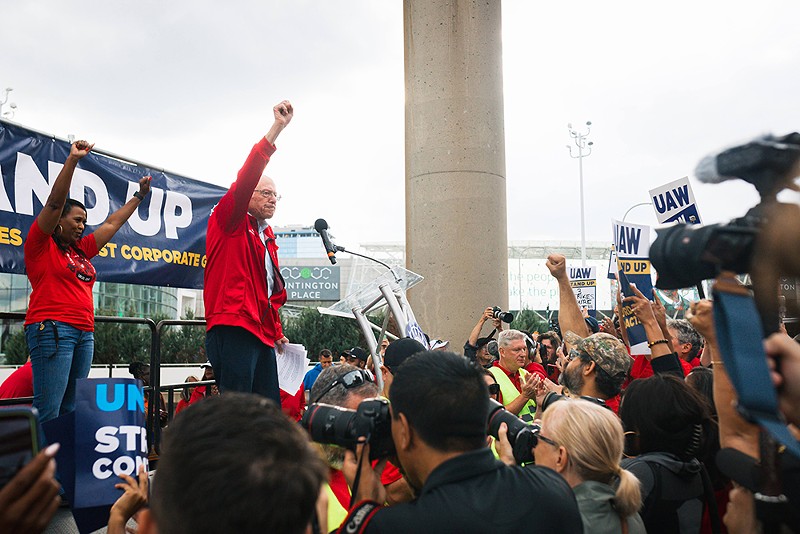
Sanders was one of the first officials to throw his support behind the UAW workers, speaking at a rally in downtown Detroit the day the strike was called, along with Gov. Whitmer, U.S. Rep. Rashida Tlaib, and others.
“The fight you are waging here is not just about decent wages and working conditions and pensions in the automobile industry,” Sanders said, not far from GM’s world headquarters, and the monuments to the labor movement in Detroit’s Hart Plaza. “It is a fight to take on corporate greed and tell the people on top this country belongs to all of us, not just a few.”
Citing a recent Gallup poll that found 75% of Americans supporting the UAW, Sanders added,“They are sick and tired of an economy in which the rich get richer, while working families struggle and the most desperate sleep out on the streets.”
There is good reason to believe that if the UAW is successful in Detroit, it could translate into gains for workers broadly. When unions win wage increases and other benefits, they are often adopted by other employers, who must now compete against the better union jobs for workers.
Today, a five-day, 40-hour workweek may be the norm, but that was something unions fought for — along with weekends, lunch breaks, paid vacation and sick leave, Social Security, overtime, child labor laws, pensions, whistleblower protection, sexual harassment laws, holidays, and the right to strike, among others — or basically everything we take for granted now.
“These things seemed unpopular and inefficient back then,” Milloy says. “We can go back and look at employers, who are always tending to predict that the next gain that workers make, especially in working hours, is what’s going to bring capitalism to its knees. We’ve had enormous gains in productivity over the past 40 years, and we’ve had technological innovation that makes shorter hours a real possibility. And yet, that hasn’t happened.”
Milloy points out that the call for a 32-hour workweek is nothing new. Ruether even considered it back in the 1940s, which he envisioned would be made possible thanks to technological breakthroughs in productivity. “Work in itself is not an end. It’s the means to an end,” he said in The New York Times. “The end is a more abundant life, to be able to conquer the job of feeding and clothing ourselves in as little time as possible, so that as civilized men we can enjoy the finer things — culture and education. That is the struggle.” In the end, Ruether wound up backing off of the 32-hour workweek, but its time could be now. In recent years, European countries have experimented with testing four-day workweeks, and the results have reportedly been overwhelmingly positive, with improvements in productivity and worker morale.
“I think it’s very interesting to see [the UAW] kind of going on offense and suggesting ideas for how society can be,” Milloy says. “Often, all the ideas we get about the future of society come from billionaires, or corporate think tanks, or The New York Times. So it’s interesting to actually have working class voices say, ‘Well, this is what we think the world could be like.’”
He adds, “I think one of the things that’s most inspiring about this strike is that it is important for working people to dream of what is possible, instead of just being told there is no alternative.”
Viola Klocko contributed to this report.
Subscribe to Metro Times newsletters.
Follow us: Google News | NewsBreak | Reddit | Instagram | Facebook | Twitter

